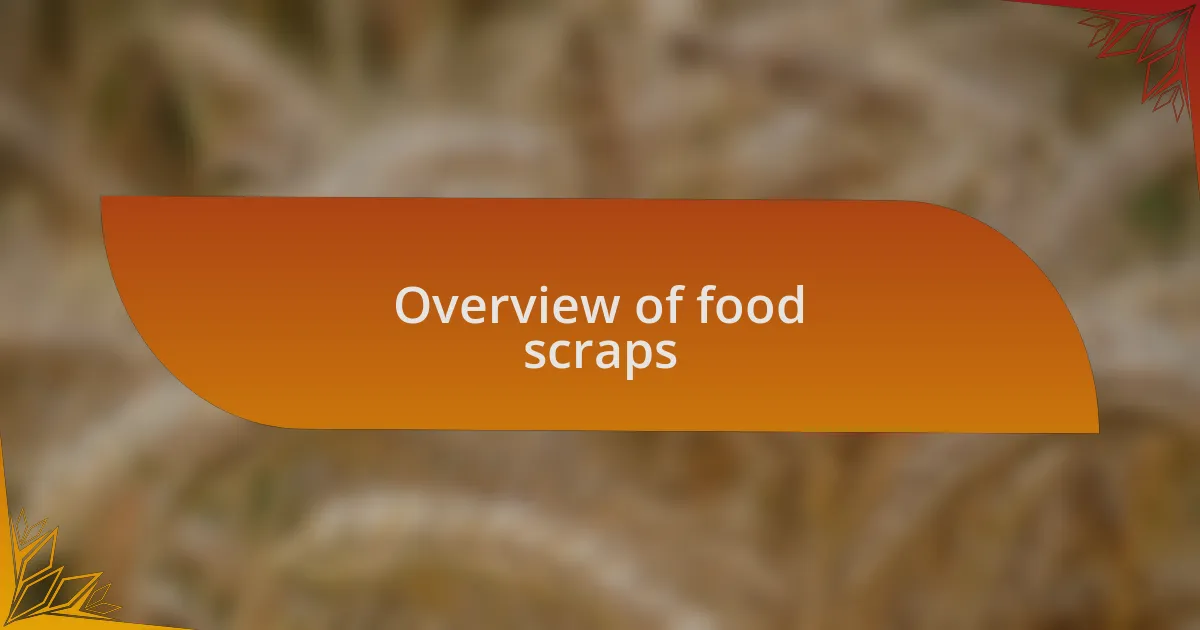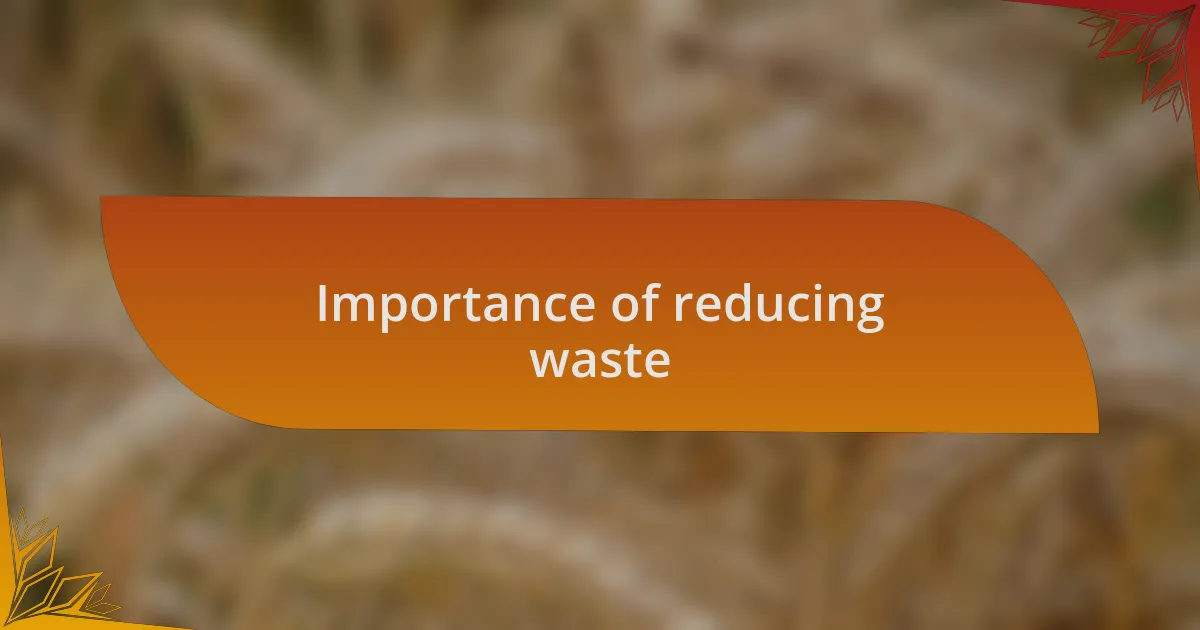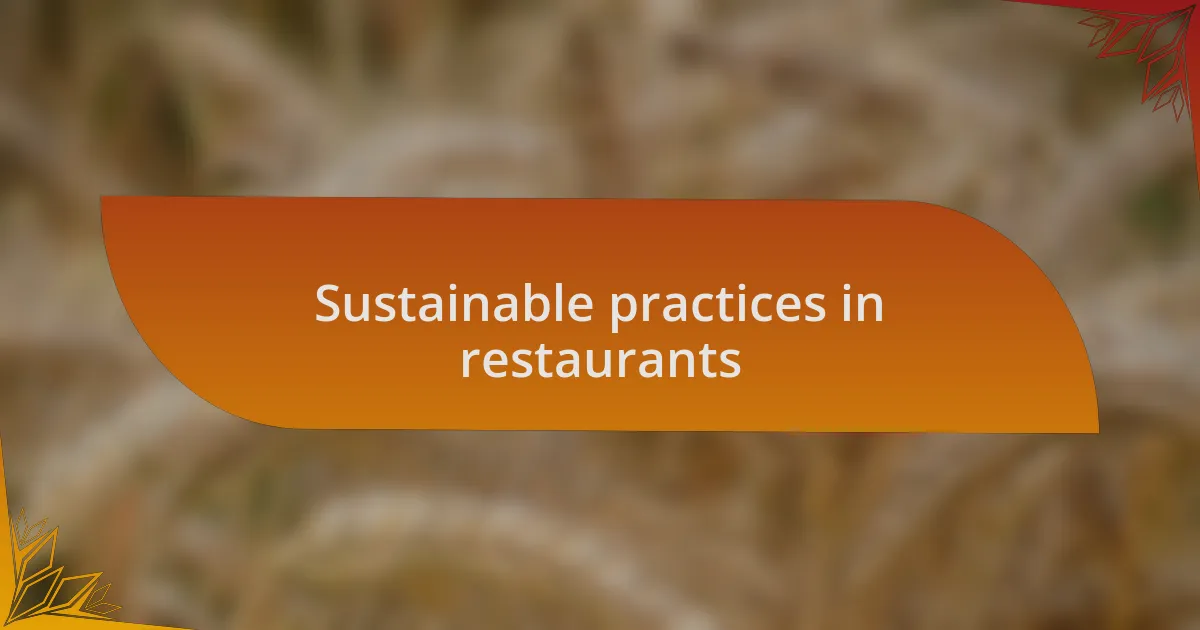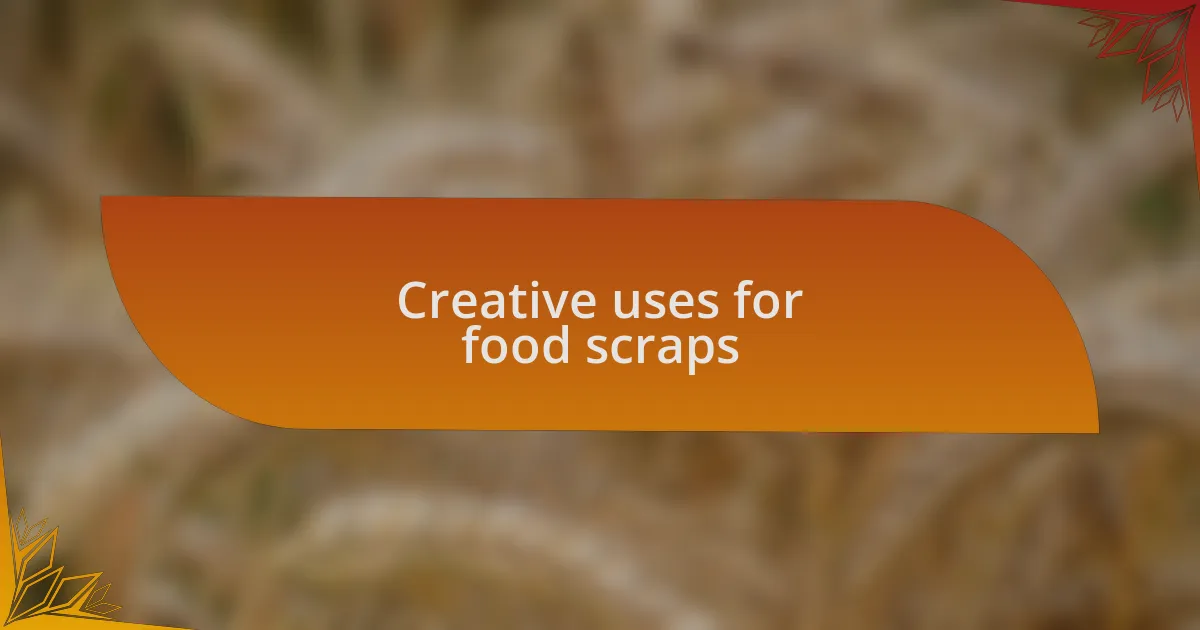Key takeaways:
- Food scraps can be transformed into valuable resources, such as broths and compost, promoting sustainability and reducing waste.
- Creative uses for food scraps, like making pestos and chips, enhance cooking and minimize reliance on store-bought ingredients.
- Composting not only reduces landfill waste but also contributes to healthier plants and a reduced carbon footprint.
- Engaging with food scraps fosters a mindset of resourcefulness and creativity, encouraging individuals to rethink their approach to waste.

Overview of food scraps
Food scraps are the unavoidable byproducts of cooking and dining. They include vegetable peels, fruit skins, and uneaten leftovers—things many of us often discard without giving it a second thought. Have you ever wondered how much potential value these scraps might hold if we just took a moment to reconsider their fate?
In my experience, food scraps can be surprisingly versatile. For instance, I once transformed vegetable trimmings into a rich broth rather than simply tossing them in the trash. This not only reduced waste but also enhanced my meals with flavors that I would have otherwise missed. Isn’t it fascinating to think about how these scraps, often seen as refuse, can contribute to something nourishing?
Moreover, I’ve noticed that when I engage with my food scraps creatively, it shifts my perspective on waste itself. Instead of viewing leftovers as a burden, I start to see them as opportunities. What if we all embraced this mindset? The possibilities can be both fulfilling and sustainable, turning our kitchens into places of resourcefulness.

Importance of reducing waste
When I reflect on the importance of reducing waste, I can’t help but recall the time I started composting my food scraps. It was eye-opening to see how quickly these once-disposed items could be transformed into nutrient-rich soil for my garden. This simple act not only minimized what went to the landfill but also reinforced my connection to the earth and the cyclical nature of food.
Every time I make an effort to cut down on waste, I’m reminded of our collective responsibility to the planet. Have you ever thought about the impact of waste accumulation? It contributes to greenhouse gas emissions and strains our natural resources. By reducing waste, I feel like I’m contributing positively to local ecosystems, which, in turn, creates a healthier environment for everyone.
There’s a profound sense of satisfaction that comes with making mindful decisions about food scraps. Recently, I started a small jar for vegetable peelings in my fridge, intending to use them for a flavorful broth later. It made me rethink how I approach meals. Instead of focusing on what I’m throwing away, I’m increasingly engaged in what I can create from what’s left. Isn’t it empowering to realize that we can all play a part in reducing waste while simultaneously nurturing our creativity and sustainability?

Sustainable practices in restaurants
One sustainable practice I’ve seen in restaurants is the integration of food scrap recycling programs. These initiatives not only reduce landfill waste but also allow eateries to repurpose their organic waste into compost, which can be used to nourish local farms. It’s incredible to watch a restaurant transform its scraps into a resource that benefits the community and the environment.
Then there’s the concept of creative menu planning to minimize waste. I remember dining at a restaurant where the chef crafted special dishes around “unsold” ingredients. This practice sparked my curiosity about how flexibility in the kitchen can lead to new flavors while preventing excess waste. Have you ever wondered how much creativity is hidden in your waste?
Another trend I find compelling is partnering with local farmers. Some restaurants use their food scraps to feed livestock or donate leftovers to community organizations. This approach not only supports local agriculture but reinforces a sense of kinship among the food system stakeholders. In my experience, when I see a restaurant committed to these practices, it inspires me to be more conscious of my own food choices and their impacts.

Creative uses for food scraps
In my kitchen, I’ve found that vegetable peels and scraps can be transformed into flavorful broths. There’s something satisfying about simmering those leftover bits in water, letting their flavors meld together into a hearty base for soups and stews. Why buy store-bought broth when you can create something unique from what would otherwise be waste?
I once kept a jar on my countertop to collect citrus peels. As the jar filled up, I made a refreshing homemade citrus vinegar. The process was simple: I mixed the peels with vinegar and let it steep for a couple of weeks. The result was a fragrant, zesty cleaner that was both eco-friendly and effective. Can you imagine the delightful aromas wafting from your own kitchen as you turn scraps into something functional?
An inspiring experience I had was when I attended a cooking class that focused on food waste reduction. The chef demonstrated how to use stale bread to make breadcrumbs or croutons, turning what I usually considered trash into a gourmet addition. This not only taught me the importance of creatively rethinking leftovers, but it also reminded me that our waste can often lead to unexpected culinary treasures. What could you discover if you took a second look at your food scraps?

Composting as a solution
Composting has become a practical solution for managing food scraps in my kitchen. When I first started composting, I was surprised by how quickly I could turn vegetable peels and coffee grounds into rich soil. It felt rewarding to know that my waste was nourishing my garden instead of piling up in a landfill. Have you ever considered how much healthier your plants could grow with such organic nutrients?
I remember a moment when I sifted through my compost bin and discovered the beautiful, crumbly soil created from my kitchen waste. It was a tangible reminder of the cycle of life and how everything connects – food scraps returned to the earth, supporting new growth. Engaging with composting not only made me feel like I was living sustainably but also sparked joy in seeing my plants thrive. Isn’t it amazing that something we often throw away can become the foundation for new life?
The act of composting goes beyond just waste management; it’s a commitment to reducing my carbon footprint. I’ve noticed a significant decrease in my trash output by actively composting, and it’s almost liberating to know I’m contributing to a healthier planet. Have you thought about how your daily habits can contribute to sustainability? Each banana peel and apple core could serve a greater purpose, reminding us that our choices truly matter.

Recipes using food scraps
Using food scraps in recipes is not only practical but also a delightful way to elevate everyday cooking. For instance, when I have leftover vegetable tops, such as those from radishes or carrots, I love to whip them into a vibrant pesto. Blending them with some nuts, garlic, and olive oil transforms what would have been waste into a flavorful condiment that pairs beautifully with pasta or spreads on sandwiches. Have you ever realized how one simple change can enhance a dish?
Another favorite dish of mine is potato peel chips. Instead of tossing those peels in the compost, I toss them with a bit of oil and seasoning and bake them until they’re crispy. It’s a fantastic snack that makes use of what many overlook. I often find myself asking, how did I not think of this sooner? The sheer crunch and flavor remind me that reducing waste can be delicious.
Lastly, I’ve discovered that citrus peels can work wonders in marinades and dressings. I zest them into homemade salad dressings for a bright kick or even steep them in vinegar to create a refreshing, aromatic infusion. It’s fascinating how these simple additions can awaken flavors in a dish. Have you tried using your food scraps creatively? You might just find your new favorite recipe buried in what you once considered trash.

Personal experiences with food scraps
When I first started experimenting with food scraps, I discovered the joy of using onion skins to create a rich vegetable broth. Initially, I was hesitant, thinking that they were too bitter or would ruin the taste. But I decided to give it a try after stumbling across a recipe that encouraged using everything. The result was a flavorful broth that not only deepened my soups but also made me feel like I was honoring every part of the vegetable. Have you ever felt that sense of accomplishment from not letting anything go to waste?
One of my personal favorites is regrowing green onions from the scraps. After chopping the tops for a stir-fry, I simply place the roots in a small glass of water by my kitchen window. Watching them sprout fresh greens each week brings a bit of nature into my home, and I can’t help but feel a tiny rush of pride each time I snip off a few more for my meals. It makes me wonder, what else could I be growing right from my countertop?
A particularly memorable instance was when I used leftover bread to create croutons. I had a bag of stale bread sitting in my pantry, and instead of tossing it out, I cubed it, tossed it with olive oil and herbs, and baked it until golden. The smell wafting through my kitchen was heavenly, and when I topped my salad with those crispy croutons, it felt like a small victory. Doesn’t it feel good to turn what you once considered waste into something enjoyable?